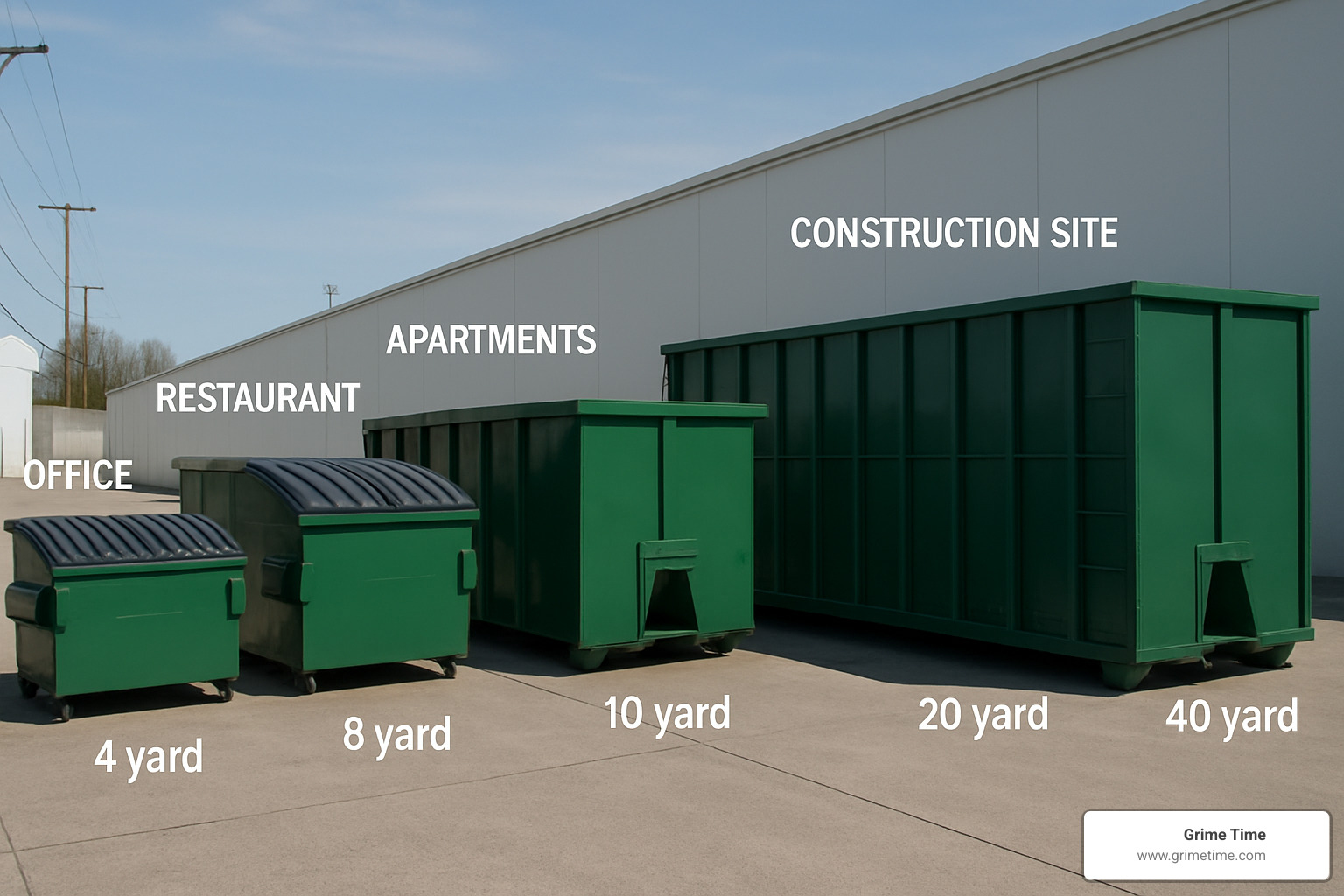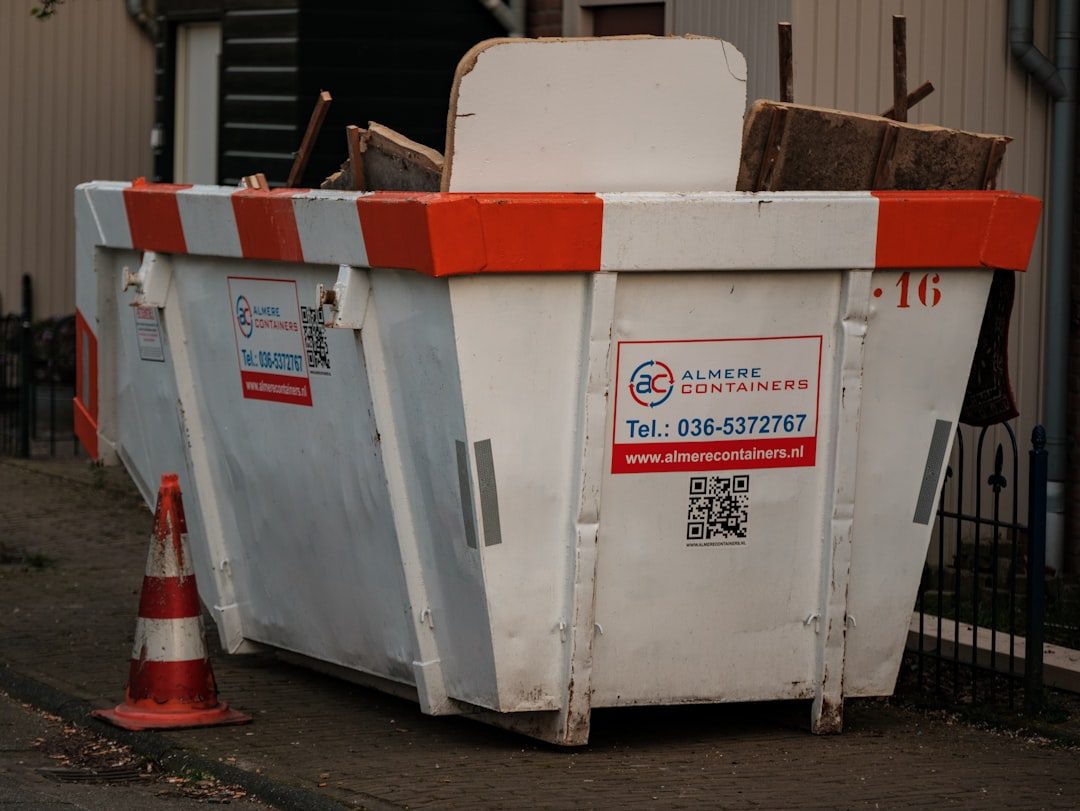Why Commercial Waste Management Matters for Your Business
Commercial dumpster service provides ongoing waste collection for businesses through scheduled pickups of permanent containers, typically ranging from 2-8 yard front-load dumpsters or 10-40 yard roll-off containers. Here’s what you need to know:
Key Service Features:
– Container sizes from 2-8 yards (front-load) or 10-40 yards (roll-off)
– Pickup frequency from weekly to 6 times per week
– Contract terms typically 12-36 months with cost savings for longer agreements
– Dedicated account managers for service changes and support
– Flat-rate pricing that includes container rental, disposal, and pickup
Common Business Applications:
– Small offices (2-4 yard containers for under 100 employees)
– Restaurants and retail (4-6 yard for medium volume waste)
– Warehouses and manufacturing (6-8 yard for high-volume operations)
– Construction sites (roll-off containers for project debris)
When you’re running multiple job sites across Central Texas, reliable waste management isn’t just convenient – it’s critical for keeping projects on schedule. Poor service means missed pickups, overflowing containers, and potential code violations that can shut down your operations.
The commercial dumpster industry has evolved beyond simple trash collection. Modern providers offer waste audits, recycling programs, and digital account management that can cut your disposal costs significantly. Some businesses report reducing waste expenses by up to 48% through optimized container sizing and pickup schedules.
The biggest pain points contractors face include hidden fees, unreliable pickup schedules, and poor customer service when changes are needed. This guide breaks down exactly what to look for in a commercial waste partner and how to avoid the common pitfalls that cost time and money.

Key Commercial dumpster service vocabulary:
– Professional waste management
– Industrial dumpster rental
– Affordable waste services
Why This Guide Matters
If you’re searching for commercial dumpster rentals, you’re likely dealing with one of these scenarios: expanding your business operations, switching from an unreliable provider, or setting up waste management for a new location. The stakes are high – choosing the wrong service can lead to compliance issues, unexpected costs, and operational headaches.
This product roundup cuts through the marketing fluff to give you the real information you need. We’ll cover cost transparency (including those sneaky fees that show up later), local regulations that vary by municipality, and the service features that actually matter for your bottom line.
In Central Texas, where we operate across Austin, Georgetown, Round Rock, San Marcos, and surrounding areas, local regulations can vary significantly. What works in Austin might not fly in Cedar Park, and understanding these differences upfront saves you from costly surprises down the road.
Commercial Dumpster Service: Choosing the Right Partner
Finding the right commercial dumpster service partner isn’t just about who has the cheapest price – it’s about finding a company that understands your business and keeps things running smoothly.
What Is Commercial Dumpster Service and How Does It Work?
Commercial dumpster service is basically your business’s waste management on autopilot. Instead of scrambling to find someone to haul away your trash every week, you get a permanent container and a reliable pickup schedule that just… works.
You sign an ongoing rental agreement (usually 12 to 36 months), and your provider handles everything from there. They drop off your container, set up regular pickups based on how much waste you actually generate, and take care of all the behind-the-scenes stuff.
The best part? You get a dedicated account manager who actually knows your business. Need an extra pickup because you’re swamped? Call them. Want to switch from weekly to twice-weekly service? They’ve got you covered.
Your service typically includes the container rental, scheduled pickups, disposal fees, and often extras like online account management where you can track billing and request service changes. Many providers will even do a waste audit to make sure you’re not paying for way more capacity than you need.
Contract length might seem like fine print, but it actually matters for your wallet. Longer agreements (think 3 years instead of 1) can save you $15-30 per month because your provider can spread out their delivery costs and offer more stable pricing.
Benefits of Commercial Dumpster Service for Businesses
The biggest win is getting your time back. Instead of juggling multiple vendors or dealing with the headache of missed pickups, you have one person to call for everything waste-related. If you’re managing multiple locations, this becomes even more valuable.
Liability protection is another huge benefit that many business owners don’t think about until it’s too late. Professional waste services handle proper disposal, stay on top of recycling requirements, and keep all the paperwork straight. If you’re dealing with any regulated materials or work in an industry with specific waste rules, this professional oversight can save you from expensive violations.
Then there’s compliance support. Environmental regulations keep getting more complex, and a good commercial service stays current with all the local recycling mandates, hazardous waste restrictions, and disposal reporting requirements.
| Service Tier | Container Options | Pickup Frequency | Account Management | Additional Features |
|---|---|---|---|---|
| Basic | 2-4 yard front-load | Weekly to bi-weekly | Shared customer service | Standard billing |
| Professional | 2-8 yard front-load, 10-30 yard roll-off | Daily to weekly | Dedicated account rep | Online portal, waste audits |
| Enterprise | Full size range, multiple containers | On-demand to 6x weekly | Priority support team | Multi-location billing, sustainability reporting |
When you’re evaluating potential partners, Features of a Reliable Dumpster Rental Company can help you look beyond just the price tag to find a provider who’ll actually be there when you need them.
The key difference between front load and roll off service comes down to your business needs. Front load containers work great for ongoing operations – they’re compact, get serviced regularly, and don’t take up much space. Roll off containers are better for businesses with variable waste volumes or when you need the flexibility to load from the top.
Dumpster Types, Sizes & Must-Have Features
Getting the right container size isn’t just about fitting your waste – it’s about avoiding those painful moments when you’re either paying for empty space or watching trash overflow onto your property.

Front Load vs Roll Off Breakdown
Front load dumpsters are the workhorses of commercial dumpster service. These 2-8 yard containers sit permanently at your location and get emptied by trucks that lift them from the front. They’re there every day, handling your regular trash flow with scheduled pickups that keep everything running smoothly.
Roll off containers are the heavy lifters, ranging from 10-40 yards. These open-top containers get delivered and picked up by specialized trucks that literally roll them off the truck bed. They’re perfect when you need serious capacity – construction projects, major cleanouts, or businesses with unpredictable waste volumes.
The service rhythm differs completely between the two. Front load containers typically get emptied weekly to several times per week, keeping your daily operations clean and compliant. Roll off containers work more like a taxi service – they come when you call and leave when you’re done.
Picking the Perfect Size for Your Waste Stream
2-yard containers handle about 12-15 standard trash bags or roughly 400 pounds. These compact workhorses are perfect for small offices, banks, or professional services with up to 25 employees.
4-yard containers step up to handle 24-27 large bags or 800 pounds of waste. They’re the sweet spot for medium businesses – think dental offices, small restaurants, or growing companies with up to 100 employees.
6-yard containers accommodate the waste from larger operations – about 36-41 large bags or 1,200 pounds. These work well for busy restaurants, retail stores, or offices with 200-250 employees.
8-yard containers are the largest front-load option, holding roughly 48-54 large bags or 1,600 pounds. These are built for warehouses, large restaurants, manufacturing facilities, or businesses with 400-500 employees where waste generation is serious business.
Roll off containers work differently, measured by volume rather than bag count. A 10-yard container holds about 4 pickup truck loads, while a 20-yard handles 8 truck loads. The 30-yard accommodates 12 truck loads, and the massive 40-yard container can handle 16 full pickup truck loads of material.
Employee count guidelines are helpful starting points, but your actual waste stream tells the real story. A busy restaurant with 50 employees might generate more waste than a quiet office with 200 people, thanks to food waste and packaging materials.
Commercial Roll Off Dumpster Rental in Texas provides detailed information about larger containers for construction and industrial projects.
Smart Add-Ons & Enclosures
Lock bars might seem like a small detail, but they’re worth every penny of the $20-50 monthly cost. Nothing ruins your day like finding someone dumped prohibited materials in your container, triggering contamination fees and service delays.
Wheels cost about the same monthly but solve different problems. Being able to move your container for cleaning, deliveries, or maintenance access is incredibly convenient.
Drain plugs prevent the gross factor that comes with liquid accumulation. For $20-50 monthly, you avoid odors, pest problems, and that unpleasant surprise when you lift the lid.
When it comes to enclosure best practices, think like a service truck driver. You need minimum 14 feet of overhead clearance and 12 feet of width for safe access. Avoid low-hanging wires, branches, or structures that could damage equipment or delay service. Level placement prevents containers from shifting and creating access problems.
Scheduling, Compliance & Sustainability
Modern commercial dumpster service goes far beyond simple trash pickup. Today’s businesses need providers who understand complex waste streams, regulatory requirements, and sustainability goals that can make or break your operations.
![]()
The scheduling flexibility you get with professional commercial service is remarkable. Most providers offer pickup frequencies from weekly service for smaller operations all the way up to six times per week for high-volume businesses like busy restaurants or manufacturing facilities. The key is finding that sweet spot where your containers never overflow but you’re not paying for unnecessary pickups.
What many business owners don’t realize is how much local recycling mandates can affect their service needs. Austin, for example, has different requirements than Round Rock or Georgetown. Some municipalities require businesses over certain sizes to have recycling programs, while others mandate organic waste separation for restaurants and food service operations.
Employee training becomes crucial when you’re dealing with multiple waste streams. Your staff needs to understand what goes where, especially when you’re managing single-stream recycling, cardboard-only programs, and organic waste separation.
What Can and Can’t Go in the Dumpster
Understanding what belongs in your dumpster saves you from surprise fees and service disruptions. Approved materials cover most of what your business generates daily – general office waste like paper and packaging, non-hazardous manufacturing debris, cardboard, furniture that fits properly, and non-regulated construction materials.
The prohibited items list is where things get tricky. Hazardous chemicals, electronics, batteries, automotive fluids, medical waste, asbestos, liquids, and oversized items that won’t fit properly are universally banned. But here’s what catches many businesses off guard – the definition of “hazardous” can be broader than you think.
Contamination fees typically run $50-200 per incident, and they add up fast. We’ve seen businesses get hit with multiple fees in a single month because employees weren’t clear on disposal rules. The solution? Post clear guidelines near your containers and designate specific staff members as waste management coordinators.
For specialized items like batteries, resources like Battery disposal guide: Safety above all provide crucial safety information that protects both your business and the environment.
Meeting Local Rules & Green Goals
Permit requirements across Central Texas vary more than you might expect. Austin has different container placement rules than Georgetown or Round Rock, and what works in one city might violate regulations in another.
Waste audits are becoming standard practice for businesses serious about cost control and sustainability. These assessments analyze your actual waste stream to identify opportunities for right-sizing container capacity, optimizing pickup frequency, increasing recycling and diversion, and reducing overall waste generation.
Diversion reporting is increasingly required for larger businesses or government contracts. Your provider should offer documentation showing how much waste was recycled versus sent to landfills.
For comprehensive recycling guidance beyond basic dumpster service, RecyclingSimplified.com offers detailed information about managing complex waste streams and meeting sustainability goals.
Cost Factors, Billing & Money-Saving Tips
Let’s talk money – because understanding commercial dumpster service pricing helps you make smart decisions and avoid those nasty surprise bills that can wreck your budget.
The biggest mistake businesses make? Focusing only on the monthly rate without understanding what’s actually included. We’ve seen companies switch providers to save $20 per month, only to get hit with fuel surcharges, environmental fees, and overage charges that cost them hundreds more annually.

Breaking Down Your Quote
Flat-rate pricing is your friend here. When everything’s bundled into one monthly charge – container rental, pickup service, disposal fees, and transportation – you know exactly what you’re paying. No surprises, no monthly guessing games about what your bill will be.
Variable pricing might look tempting with that lower base rate, but it’s like buying a car and then getting charged separately for the wheels. Those fuel surcharges can fluctuate monthly based on gas prices. Environmental fees and administrative charges appear out of nowhere. Overage fees hit when you exceed weight limits you didn’t even know existed.
Location matters more than you’d think. If you’re in a remote area outside the main service routes, transportation costs go up. But here in Central Texas, serving everywhere from Austin to Georgetown to San Marcos, we’ve optimized our routes to keep costs fair regardless of your location.
Container size affects pricing, but bigger isn’t always more expensive per cubic yard. A 6-yard container might cost only $40 more monthly than a 4-yard, but provides 50% more capacity.
Pickup frequency is where smart businesses save money. Weekly service costs significantly less per pickup than daily service, but you need enough capacity to handle the waste between pickups. Getting this balance right can cut your monthly costs by 30-40%.
Contract length offers real savings for businesses planning to stay put. Three-year agreements typically run $15-30 less monthly than one-year contracts. That’s $180-360 in annual savings just for committing to a longer term.
For detailed pricing specific to your situation, our Dumpster Rental Pricing guide breaks down all the factors that affect your costs.
Billing for Multi-Site Operations
Managing waste service across multiple locations can be a nightmare – or it can be simple. The difference is finding a provider who understands business operations beyond just emptying dumpsters.
Consolidated billing means one invoice for all your locations instead of juggling multiple vendor relationships. Your accounting team will thank you when they’re processing one payment instead of five separate bills from different providers.
Single point of contact eliminates the phone tag between different account managers. Need to add a container at your Round Rock location? Want to adjust pickup frequency in Austin? One call handles everything.
Digital account management lets you handle routine requests online. Check service history, submit work orders, or review invoices for all locations through one portal.

Frequently Asked Questions about Commercial Dumpster Service
How often can I schedule pickups?
Commercial dumpster service pickup schedules are surprisingly flexible. Most providers offer everything from weekly service up to six pickups per week, depending on what your business actually needs.
Weekly pickups work perfectly for most small offices and businesses that generate steady, manageable amounts of waste. But restaurants, busy retail stores, and manufacturing operations often need 2-3 pickups per week to stay on top of their waste volume.
Here’s what many business owners don’t realize: you can adjust your pickup frequency as your needs change. Your account manager should work with you to monitor how full your containers get between pickups. If you’re consistently half-empty, you might be paying for more service than you need.
Seasonal adjustments make a huge difference for many businesses. Retail stores often need extra pickups during holiday shopping seasons, while construction companies might reduce service during slower winter months.
What size container suits my employee count?
Employee count gives you a starting point, but it’s not the whole story. A busy restaurant with 25 employees will generate way more waste than a quiet accounting office with 100 people.
Here’s a rough guide based on employee count: 2-yard containers work for up to 25 employees in typical office settings, 4-yard containers handle up to 100 employees, 6-yard containers suit businesses with up to 250 employees, and 8-yard containers can serve operations with up to 500 employees.
But business type matters more than headcount. That restaurant we mentioned? They’re dealing with food waste, packaging from suppliers, and trash from customers – all of which adds up fast. A retail store receives constant shipments with boxes and packaging materials.
Consider what you’re actually throwing away: customer traffic generates extra waste, food service creates different disposal needs than office work, and businesses that receive frequent shipments deal with lots of packaging materials.
How do I switch providers without service gaps?
Switching commercial dumpster service providers without creating a mess requires some planning, but it’s totally doable. The worst-case scenario is having your old container picked up before your new one arrives.
Start by checking your current contract for cancellation requirements. Most commercial agreements need 30-60 days notice, and some have early termination fees if you’re switching before your contract ends.
Plan your timeline carefully. Begin researching new providers about 60 days before you want to switch. This gives you time to get quotes, check references, and make sure your new provider can actually deliver what they promise.
The critical coordination happens in the final two weeks. Schedule your new container delivery for the same day or ideally the day before your old container gets picked up. Make sure your new provider knows exactly where you want the container placed and understands your pickup schedule from day one.
The best providers will actually help coordinate this transition with you. They understand that seamless service matters to your business operations, and they’ll work to make sure there’s no gap in your waste management coverage.
Conclusion

Finding the right commercial dumpster service shouldn’t feel like solving a puzzle with missing pieces. After helping hundreds of businesses across Central Texas, we’ve seen how the right waste management partner can transform operations – and how the wrong one can create headaches that last for years.
The businesses that succeed with commercial waste service focus on three non-negotiables: transparent pricing without surprise fees, reliable service that shows up when promised, and responsive account management that treats service changes as opportunities rather than inconveniences.
That rock-bottom quote might look tempting, but it’s rarely the best deal when you factor in missed pickups, contamination fees, and the time you’ll spend managing problems instead of running your business. The sweet spot lies with providers who offer flat-rate pricing, maintain strong local presence, and actually listen when you explain your specific needs.
Whether you’re managing a busy restaurant in downtown Austin, coordinating waste for multiple retail locations, or keeping construction sites clean across Georgetown and Round Rock, your waste partner should feel like part of your team.
At Grime Time, we’ve built our reputation on being that reliable partner. Our transparent pricing means no hidden fees, our contractor programs offer priority service when deadlines matter, and our local expertise across Austin and Central Texas means we understand the unique challenges businesses face in our market.
The right waste management setup frees you to focus on what you do best – growing your business, serving customers, and building something meaningful. Poor waste service creates distractions, compliance risks, and unnecessary costs that drain energy from your real priorities.
Ready to experience what reliable commercial waste service feels like? Contact Grime Time for customized commercial service and find how the right partnership can improve your operations while actually reducing costs. Your future self will thank you for making the switch.




